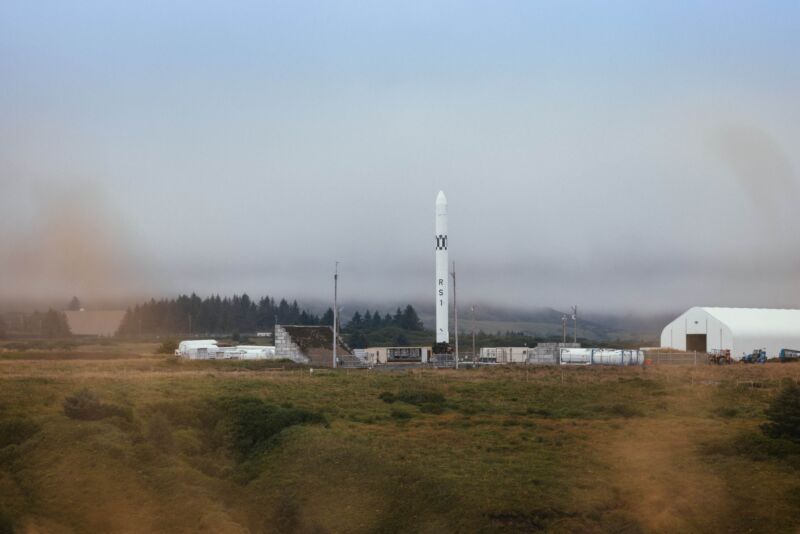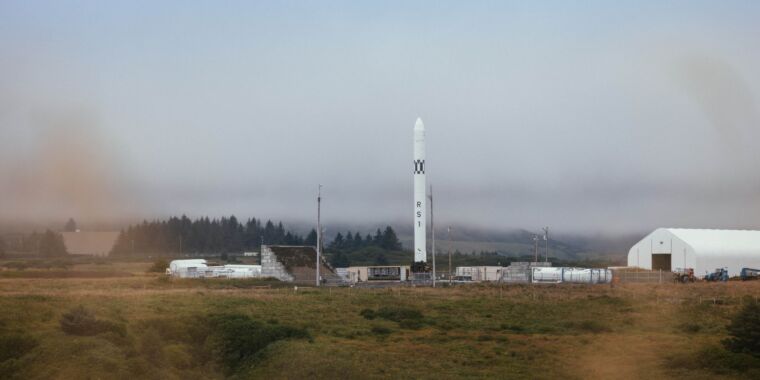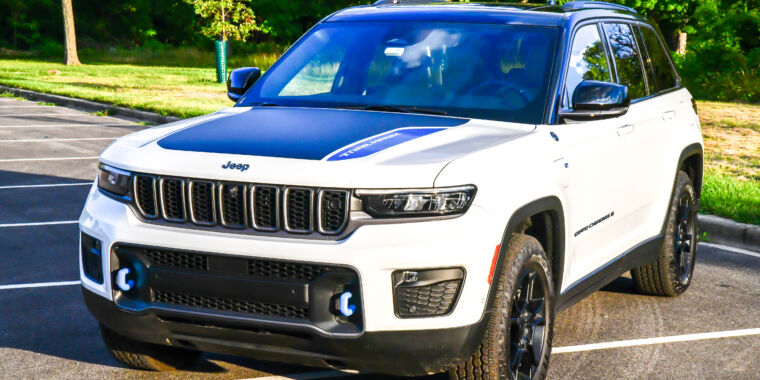
ABL Space Systems
Welcome to Edition 5.09 of the Rocket Report! Another week, and we have another attempt at launching the Space Launch System rocket. I’m looking forward to what is hopefully a clean countdown and smooth liftoff of NASA’s large rocket on Saturday afternoon from the Florida space coast. No matter what happens, I’ll do my best to keep you on top of the situation.
As always, we welcome reader submissions, and if you don’t want to miss an issue, please subscribe using the box below (the form will not appear on AMP-enabled versions of the site). Each report will include information on small-, medium-, and heavy-lift rockets as well as a quick look ahead at the next three launches on the calendar.

Rocket Lab successfully fires flown engine. In May an Electron rocket launched the “There and Back Again” mission, and then attempted to recover the first stage by catching it with a helicopter. While the pilot succeeded in briefly grappling onto the rocket, it had to be dropped due to unexpected loads on the line attached to the helicopter. Nevertheless, when Rocket Lab recovered the first stage from the ocean the company said it was in quite good condition. On Thursday, the company said it has successfully test-fired one of that rocket’s nine Rutherford engines.
Test milestones met … The refurbished Rutherford engine passed all of the same rigorous acceptance tests Rocket Lab performs for every engine, including 200 seconds of engine fire and multiple restarts, the company said. Data from the test fire shows the engine produced full thrust within 1,000 milliseconds of ignition and performed to the same standard of a newly built Rutherford engine. “The fact that the recovered components on this engine performed on the test stand with minimal rework is further validation that we’re on the right path,” Rocket Lab CEO Peter Beck said. (submitted by Ken the Bin)
Ursa Major wins Air Force contract. Rocket engine startup Ursa Major has won a US Air Force contract to support development of the company’s Hadley liquid engine for small launch vehicles, Space News reports. The $3.6 million deal is a small business innovation research contract. The agreement with the Air Force gives the 3D-printed engine a “stamp of approval” and increases customer trust in the technology, said Ursa Major founder and CEO Joe Laurienti.
A wider range of testing … Previously, the Air Force lab has been a customer of the Hadley engine—which uses liquid oxygen and kerosene propellants—to power the X-60A airdropped rocket designed for hypersonic flight research. The program supports Air Force plans to develop hypersonic missiles. With the grant, Ursa Major will test the engine’s performance in more strenuous flight conditions than what is normally expected by commercial customers. Meanwhile, the Air Force will get data on measurements of specific impulse, or ISP, combustion stability, vibration and shock profiles, and range of inlet pressures and temperatures. (submitted by Ken the Bin)
Canadian spaceport to begin construction. Maritime Launch Services announced Monday that it received all the necessary regulatory approvals to start building the spaceport in Nova Scotia, Canada. “Space launch from Nova Scotia will position Canada as a global leader in low Earth orbit satellite communications while creating hundreds of direct and indirect jobs in the province,” said Stephen Matier, president and CEO, Maritime Launch Services.
Following the rules … The company has satisfied the conditions related to construction of Spaceport Nova Scotia within the Environmental Assessment approval granted in 2019. The launch facility will be built on crown land in accordance with a 20-year lease of approximately 335 acres near the rural communities of Canso, Little Dover, and Hazel Hill, Nova Scotia. The lease includes an option for a 20-year renewal based on compliance with terms and conditions. Small- and medium-lift rockets could potentially start launching from the site in a year or two.
Firefly hires a new CEO. Firefly Aerospace has hired an executive with extensive experience in aerospace and defense as its next CEO as the company gears up for its second orbital launch attempt, Space News reports. Bill Weber will serve as the company’s new chief executive, effective immediately. Weber takes over from Peter Schumacher, a partner at majority owner AE Industrial Partners who had served as interim chief executive since mid-June when co-founder Tom Markusic stepped down as chief executive.
Just in time for a launch … Weber was previously president and chief executive of KeyW Corporation, a cyberspace operations and geospatial intelligence company serving the national security community. Jacobs acquired KeyW in 2019 for $815 million. The hiring comes as Firefly gears up for its second attempt to launch its Alpha rocket. After completing a static-fire test of the rocket’s first stage, Firefly said it is planning a launch for September 11 from Vandenberg Space Force Base in California. The “To the Black” mission will carry several CubeSats to deploy into low Earth orbit. The first attempt to launch Alpha, nearly a year ago, did not reach orbit after an engine failure.
ABL Space targets debut launch this month. Launch startup ABL Space does not have the most active Twitter account. The company joined Twitter in 2017 and only has two tweets. The first came in 2017, simply saying “Launching…” Now, nearly five years later, ABL has tweeted again, saying, “RS1 // Flight 1 // PSCA // Pad 3C // September 2022.” The tweet included a photograph of its RS1 rocket.
Kuiper coming … For those not familiar with ABL Space, it’s a company with a modular rocket designed to be shipped to a launch site in cargo containers and be rapidly assembled for launch. In the tweet, the company says the RS1 rocket will make its first flight from the Pacific Spaceport Complex in Alaska, from launch pad 3C, sometime this month. The second launch of the rocket, which could come late this year or early next, is due to carry experimental satellites for Amazon’s Project Kuiper constellation.

SpaceX aims for 100 launches in 2023. On Tuesday, from Vandenberg Space Force Base, SpaceX launched its 39th rocket of 2022. Through Wednesday, the company has now launched a Falcon 9 every 6.2 days this year, putting them on pace for an annual total of 55 to 60. I noted on Twitter that I heard from a couple of sources that SpaceX is expected to target about 100 orbital launches in 2023.
New customers, new rockets … The company’s founder, Elon Musk, confirmed this in a reply. “Yeah, aiming for up to 100 flights next year,” he wrote. Most of these will be Falcon 9 rockets, likely carrying Starlink satellites. But in the wake of Russia’s invasion of Ukraine, SpaceX has seen its manifest swell, picking up new customers such as Northrop Grumman, OneWeb, and potentially the European Space Agency. Presumably, Starship will also contribute to the company’s orbital launch count next year.
China studying reusable launcher. China’s main space contractor plans to revamp a highly successful, 30-year-old Long March rocket to include the potential for reusability, Space News reports. The two-stage rocket has a history of 62 successful launches out of 63 attempts and can loft up to 3.5 metric tons to low Earth orbit. However, the booster is based on old technology. Both stages use dinitrogen tetroxide and unsymmetrical dimethylhydrazine, a highly toxic and corrosive bipropellant mix that poses risks and costs both for launch preparation and recovery of spent stages downrange.
Fins and engines, first … Now, the China Aerospace Science and Technology Corporation says the rocket will be upgraded to use engines powered by kerosene and liquid oxygen. Additionally, the rocket has already been fitted with grid fins to help steer its flight. Previously, these were used to help constrain the area within which spent first stages fall, to keep them away from inhabited areas. But these fins could also help in a powered landing. Chinese officials say they will take other steps to adapt the Long March 2D’s first stage to be reusable. (submitted by Ken the Bin)
February targeted for Starliner test. NASA and Boeing have penciled in a February launch date for the first piloted test flight of the Starliner commercial crew capsule, Spaceflight Now reports. A launch date five months from now will allow time to implement fixes on the spacecraft after a successful uncrewed demo to the International Space Station in May this year. Boeing is completing a final report for NASA on the results from this OFT-2 mission, which had 222 flight test objectives to prove the spacecraft before the next mission flies with astronauts.
A bit of work to do … NASA astronaut Butch Wilmore, a veteran US Navy test pilot, space shuttle pilot, and space station commander, will command the Starliner Crew Flight Test. He will be joined by NASA crewmate Sunita Williams, also a former Navy test pilot. The Starliner astronauts will spend about eight days at the space station on the Crew Flight Test mission. Boeing and NASA engineers have identified four areas for “minimal” changes on the Crew Flight Test spacecraft, including some minor adjustments to the spacecraft’s Orbital Maneuvering and Attitude Control thrusters. (submitted by Ken the Bin)
Next Axiom mission to launch in 2Q 2023. NASA and Axiom Space announced this week a mission order for the second private astronaut mission to the International Space Station to take place in the second quarter of 2023. The spaceflight, designated as Axiom Mission 2 or Ax-2, will launch from NASA’s Kennedy Space Center in Florida on a Falcon 9 rocket and travel to the space station. The first Axiom mission, Ax-1, flew to and from the space station in April 2022.
Advancing commercial spaceflight … Once docked, the Axiom astronauts are scheduled to spend 10 days aboard the orbiting laboratory. NASA and Axiom mission planners will coordinate in-orbit activities for the private astronauts with space station crew members and flight controllers on the ground. “With each new step forward, we are working together with commercial space companies and growing the economy in low Earth orbit,” said Phil McAlister, director of commercial space at NASA. (submitted by EllPeaTea and Ken the Bin)

NASA scrubs initial SLS launch attempt. NASA flight controllers halted their first attempt to fly the Space Launch System Monday after they could not verify that one of the rocket’s four main engines—engine no. 3—had been properly cooled to a temperature of -420° Fahrenheit before ignition, Ars reports. The engines must be chilled to very cold temperatures to handle the injection of cold liquid hydrogen and oxygen propellants. After the attempt, NASA’s John Honeycutt said he believed the engine had actually cooled down from ambient temperature to near the required level but that it was not properly measured by a faulty temperature sensor.
Next attempt Saturday … The problem for NASA is that the sensor cannot be easily replaced and would likely necessitate a rollback to the Vehicle Assembly Building at Kennedy Space Center in Florida, a few kilometers from the launch pad. This would delay the rocket’s launch at least into October, and the space agency is starting to get concerned about wear and tear on a rocket that has now been stacked for nearly a full year. Accordingly, NASA is working on a “flight rationale” plan that would allow the rocket to launch without getting good data from the temperature sensor on the engine. The space agency is targeting another attempt on Saturday, September 3, at 2:17 pm ET (18:17 UTC).
SpaceX fires multiple Super Heavy engines. SpaceX is continuing to work through what is expected to be a lengthy test campaign for its Super Heavy rocket booster in South Texas. On Wednesday, the company reached a milestone by firing more than one engine on the large rocket for the first time, Space.com reports. However, while the company may have intended to light three Raptor engines, only two appear to have ignited on Tuesday afternoon.
Boosting the number of engines … As SpaceX gains confidence in the performance of Super Heavy’s plumbing, the static fire testing will likely continue to add more and more engines into the mix. The drama will continue to grow, as will the spectacle, because watching Booster 7 ignite all 33 of its Raptors for the first time will be quite an event. There’s no firm timetable for any of this, of course. SpaceX continues to test “Ship 24,” its latest Starship prototype, in parallel. Much work remains before an orbital flight test later this year or early next. (submitted by Ken the Bin)
Next three launches
September 2: Long March 4C | Unknown payload | Jiuquan Satellite Launch Center, China | 23:55 UTC
September 3: Space Launch System | Artemis I | Kennedy Space Center, Fla. | 18:17 UTC
September 5: Falcon 9 | Starlink 4-20 | Cape Canaveral, Fla. | 00:32 UTC









